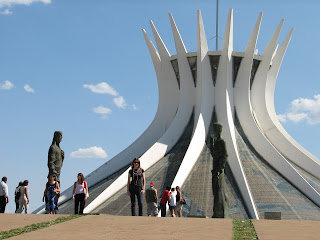
No, no, I´m not talking about haunted houses. I´m referring to what author Alain de Botton says in his book The architecture of happiness. According to him, there is a language buildings and objects speak when we look at them, and our fondness or distaste of them comes from the relationship we establish between those buildings and human beings whom we like or do not like. In other words, they remind us of people we´ve encountered in our life.
That happened to me when I visited Brasília, the capital of Brazil, for the first time. I was very excited I was going to see the buildings I knew housed the big decisions in this country.The Congress, the Senate, the Alvorada palace. I was going to actually be there and experience the work of architect Oscar Niemeyer, the man who designed that city, built in the 1960´s, during the government of President Juscelino Kubitschek.I was finally going to have a glimpse of what these two men thought Brazil should look and be like.
I was very disappointed when I got there. As I tried to connect with the buildings, they didn´t even try to connect with me. They were mute. Concrete giants enclosed within themselves.
That´s when I began realizing what de Botton says. Those buildings, and Brasília as a whole, for the landscape is uniform, reminded me of what I find most obnoxious in certain people, especially when they are powerful: selfishness, lack of empathy and that attitute of owning the world. In a paradox, I felt suffocated in a place where empty spaces are abundant. There are no sidewalks, there are almost no trees ( in a country full of trees), the air is dry to the point of gasping. The only positive aspect of Brasília, for me, is the people: kind, friendly, warm. And that takes me to another realization about my country.
For many decades now, Brazil has been trying to be modern, developed, respected. And in some ways we´re reaching that. But the concept of modern in the minds of our past leaders (and some present ones, too) was linked to the idea of rupturing with the past at any cost. For the country of the future, anything that resembled our colonial past had to go.Wood, brick, clay, intricate shapes, bright colors either resembled Europe, or the jungle, or the slave quarters. In the anxiety of finding a face in the mirror that could match the idea of new, they chose concrete. Cold, mute concrete. Had they looked more closely, they´d have seen that´s not the Brazilian face. The Brazilian face is every face. And that´s where novelty is: in diversity. Instead of wasting time and money trying to build huge concrete structures to show up to the world, they should have tried to build a fair society first.

1 comment:
Beautifully expressed. thanks
Post a Comment